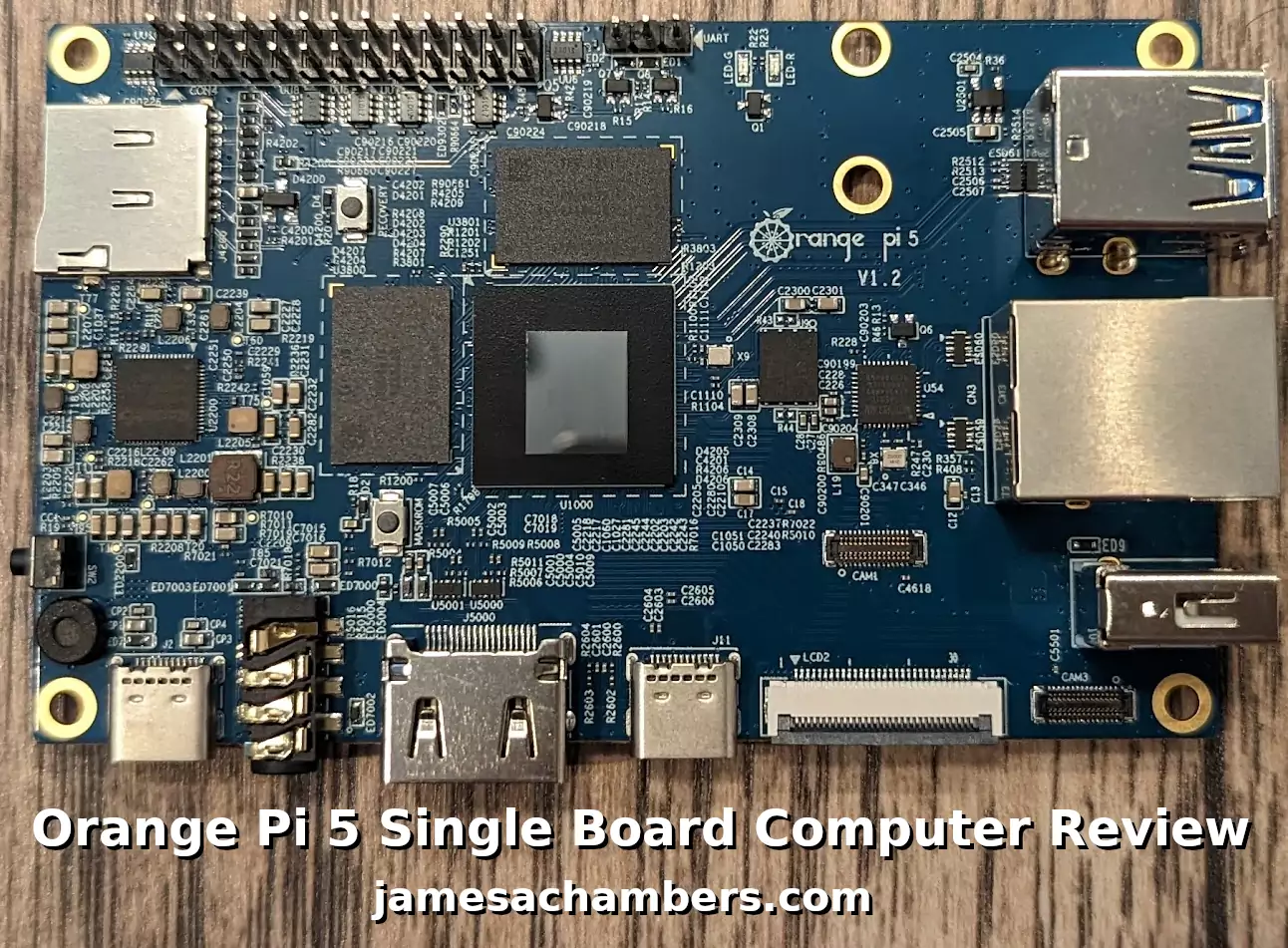
The Orange Pi 5 has finally arrived! I received my pre-order and the board is great. So should you go out and buy it? Probably, but there are some things you should know first that you may not be expecting.
The biggest thing to know is that there is no WiFi/Bluetooth included. If you were planning on using Ethernet anyway this doesn’t have much of an impact. If you do need wireless capabilities we’ll cover what options are available.
In this review we’ll cover what you need to know about the Orange Pi 5 including it’s onboard capabilities, the available RAM options as well as benchmark the board. Let’s get started!
Hardware Used
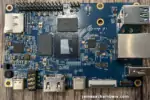
The Orange Pi 5 the latest release from Orange Pi and is the most powerful model yet. It has a 6 core CPU and options from 4GB of RAM all the way up to 32GB of RAM!
Links: Amazon.com*, AliExpress*, Amazon.ca*, Amazon.co.uk*, Amazon.de*, Amazon.es*, Amazon.fr*, Amazon.it*, Amazon.nl*, Amazon.pl*

The Geekworm copper heatsink set is designed to fit many different single board computers. It uses thermal conductive adhesive which many “cheap” heatsink kits for SBCs don’t have. Eliminates hotspots and reduces throttling. Can be further enhanced by powered cooling over the heatsinks.
Links: Amazon.com*, Amazon.ca*, Amazon.co.jp*, Amazon.co.uk*, Amazon.de*, Amazon.es*, Amazon.fr*, Amazon.it*
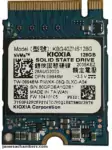
The Kioxia (Toshiba) 128GB M.2 2230 PCIe NVMe drive is much shorter than most NVMe drives (full size is 2280). It fits great with single board computers / tablets / other smaller form factors.
Links: Amazon.com*, Amazon.ca*, Amazon.co.uk*, Amazon.co.jp*, Amazon.com.au*, Amazon.de*, Amazon.es*, Amazon.fr*, Amazon.it*, Amazon.nl*, Amazon.pl*, Amazon.se*, Amazon.sg*

The Orange Pi official mouse uses 2.4GHz wireless to give you a wireless mouse experience with the Orange Pi
Links: Amazon.com*, AliExpress*

The Orange Pi monitor is meant to be a portable monitor you can take anywhere. It has a resolution of 1080P and features a hinge in the back that folds out to support the monitor.
Links: Amazon.com*, AliExpress*
Custom WiFi Module (Added 1/13/2023)

The Orange Pi 5 official wireless module is designed to fit into a M-keyed M.2 slot (the only one the Orange Pi 5 has). This WiFi adapter will work with both Linux and Android.
Links: Amazon.com*
Specifications
| CPU | 8-core 64-bit processor Big.Little Architecture: 4xCortex-A76 and 4xCortex-A55 Big core cluster is 2.4GHz Little core cluster is 1.8GHz frequency |
| GPU | Mali-G610 MP4 “Odin” GPU Compatible with OpenGL ES1.1/2.0/3.2 OpenCL 2.2 and Vulkan 1.2 3D graphics engine and 2D graphics engine |
| NPU | Built-in AI accelerator NPU with up to 6 TOPS Supports INT4/INT8/INT16 mixed operation |
| PMU | RK806-1 |
| RAM | 4GB/8GB/16GB/32GB (LPDDR4/4x) |
| Memory | QSPI Nor FLASH 16MB MicroSD (TF) Card Slot M.2 M-KEY Socket |
| USB | USB3.0 × 1 USB2.0 × 2 Type-C (USB3.1) ×1 |
| Video Output | HDMI2.1, up to 8K @60Hz DP1.4 (DisplayPort) DP 1.4 and USB 3.1 ports are multiplexed and the port is shared with Type-C 2 * MIPI D-PHY TX 4Lane Configurable up to 4K @60Hz |
| Camera | MIPI CSI 4Lane 2 * MIPI D-PHY RX 4Lane |
| Audio | CODEC: ES8388 3.5mm headphone jack audio input/output Input: Onboard MIC HDMI 2.1 eARC |
| Ethernet | 10/100/1000Mbps Ethernet |
| Expansion Port | For extending UART, PWM, I2C, SPI, CAN and GPIO interfaces. |
| M.2 M-KEY Socket Expansion Slot | Supports PCIe NVMe SSD Supports custom PCIe Wi-Fi 6 + Bluetooth 5.0 module |
| Button | 1×MaskROM key 1×Recovery key 1×On/Off key |
| Power Source | Support Type-C power supply 5V @ 4A |
| LED | Power indicator: red Status indicator: green |
| Debugging | 3 Pin debug serial port (UART) |
| Supported OS | OrangePi OS (Droid) OrangePi OS (Arch) Ubuntu Debian Android12 |
| Dimensions | 62mm*100mm |
| Weight | 46g |
Build Quality
The Orange Pi 5 is built very well. Everything is clearly labeled and visible. The PCB is a nice blue color. I received board revision/version 1.2.
Here is the top view:
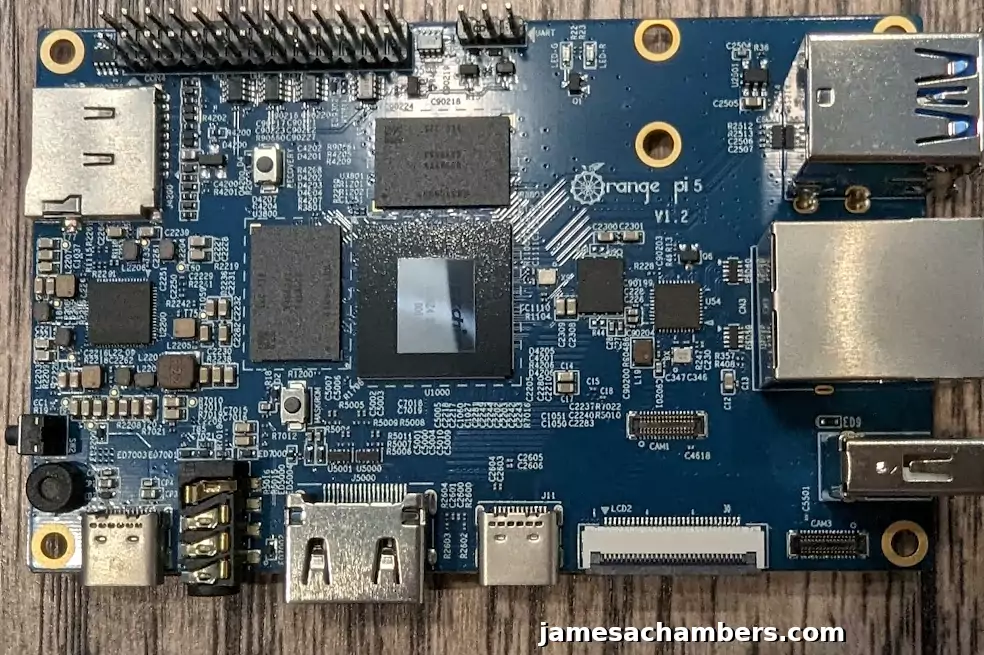
You can see the holographic effect on the RockChip CPU in the middle of the board. As you move it in the light you get a neat little effect.
The bottom of the board only contains a few connections such as the M.2 slot, a CAM slot and a couple others.
Here’s the bottom view:
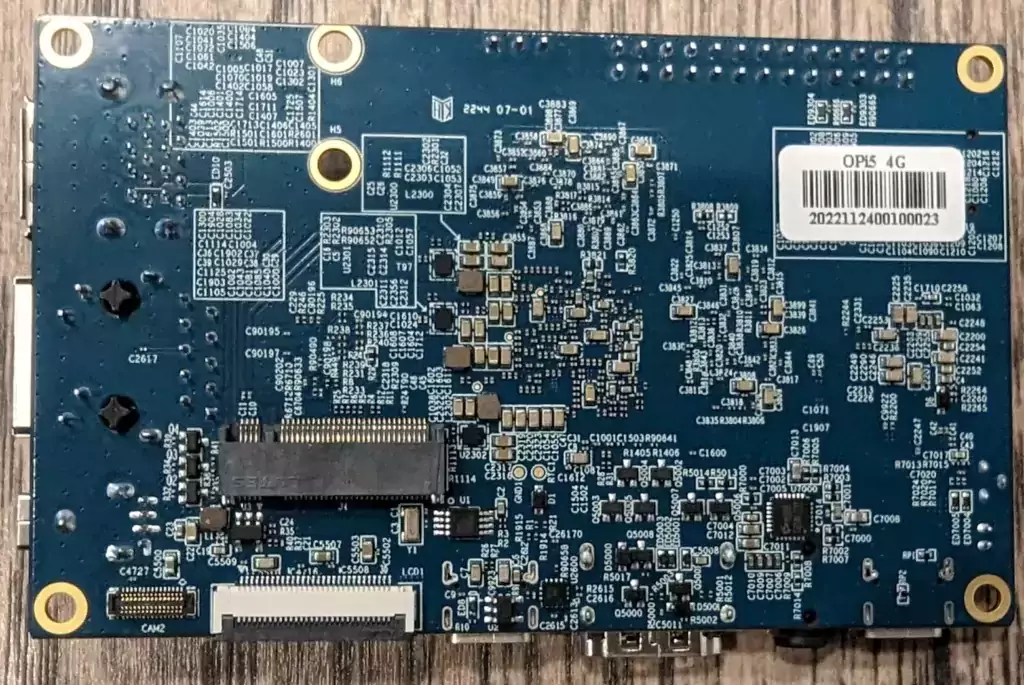
I/O Benchmarking
For the review I used a SSSTC 128GB 2230 M.2 NVMe drive. These are available on Amazon for around $10-12 (also see Kioxia 128GB M.2 2230 module*).
You can verify the performance of your drive on Pi Benchmarks using the following command:
sudo curl https://raw.githubusercontent.com/TheRemote/PiBenchmarks/master/Storage.sh | sudo bashHere are the results:
Category Test Result
HDParm Disk Read 375.32 MB/s
HDParm Cached Disk Read 381.15 MB/s
DD Disk Write 234 MB/s
FIO 4k random read 47080 IOPS (188321 KB/s)
FIO 4k random write 35128 IOPS (140514 KB/s)
IOZone 4k read 75628 KB/s
IOZone 4k write 67285 KB/s
IOZone 4k random read 35874 KB/s
IOZone 4k random write 70620 KB/s
Score: 17,718
The full Orange Pi 5 benchmark can be viewed here on Pi Benchmarks.
That is an outstanding score. We are getting NVMe performance. This score actually even beats my ODROID M1 benchmark.
The Orange Pi 5 is without a doubt a very powerful board and is performing exactly where it should be.
Keep in mind that this is PCIe 2.0 performance. This board does not have PCIe 3.0 (only the RK3588 proper has that, not the RK3588S).
UPDATE 1/2/2023: If you update the Orange Pi 5 firmware by using sudo orangepi-config and choosing “System->Firmware” and then choose to update the firmware I was able to get *low* PCIe 2.0 performance (about 280MB/s). I highly recommend updating the firmware with sudo orangepi-config. You may see some marginal improvements!
Due to this you should not use a powerful NVMe drive with the Orange Pi 5. You are limited in speeds to around 500MB/s at best (according to Orange Pi themselves via the user manual) and more like 250MB/s write according to the benchmarking.
If you need help setting up SSD booting see my Orange Pi 5 SSD Boot Guide here.
Benchmarking vs. Pi 4 (added 12/16/2022)
I’ve now installed my heat sinks which looks like this:

That means it’s time for a head-to-head benchmarking match against the Pi 4 to see how the Orange Pi 5 compares. For the benchmark I used the “hardinfo” benchmark which can be installed on most Linux flavors with:
sudo apt install hardinfoHere are the results:
| Test | Orange Pi 5 | Pi 4 |
| CPU Blowfish (lower is better) | 2.65s | 5.24s |
| CPU CryptoHash (higher is better) | 574.49 MiB/s | 466.37 MiB/s |
| CPU Fibonacci (lower is better) | 0.5s | 1.73s |
| CPU N-Queens (lower is better) | 4.24s | 8.74s |
| CPU Zlib (higher is better) | 0.80 | 0.31 |
| FPU FFT (lower is better) | 1.23s | 5.52s |
| FPU Raytracing (lower is better) | 2.86s | 2.18s |
| GPU Drawing (higher is better) | 2064.13 HiMarks | 1708.15 HiMarks |
That is almost a clean sweep for the Orange Pi 5! The only category it didn’t win was FPU raytracing interestingly enough. On GPU drawing performance however the Orange Pi 5 scored significantly higher and also won all other categories.
Pros / Cons
Pros
- 4 GB and 8 GB RAM variants cost under $100
- M.2 slot supports high speed NVMe storage
- RAM options from 4 GB all the way up to 32 GB available
Cons
- No WiFi or Bluetooth included (requires either adapter for the M.2 slot or a USB adapter to get WiFi/Bluetooth capabilities)
- No eMMC option
- PCIe speeds are limited to 500MB/s (PCIe 2.0, benchmarks show closer to 250MB/s write or PCIe 1.0 performance) — this is slower than SATA3
Conclusion
The Orange Pi 5 feels almost perfect except for the lack of built in WiFi / Bluetooth. This seems like a surprising choice on what seems like is portrayed as their “flagship” model. Fortunately it is easy to add WiFi/Bluetooth on the board via either the custom M.2 wireless PCB or by using one of your USB ports and just using a USB-based WiFi/BT chip.
The board performs extremely well. The GPU is powerful on the board and feels very snappy while using the desktop OS and applications. This board would be a good choice for almost any use case. It would make a great Minecraft server as well.
I’d recommend this one for just about anyone. The price is right. There are widely varying amounts of RAM available depending on what you need. There are good Linux and Android images available even at launch. At under $100 for the 4 GB – 8 GB the Orange Pi 5 is priced well in this market especially for the power and flexibility it offers!
Other Resources
I’ve also covered how to install Steam on the Orange Pi 5 here
I’ve also reviewed the Orange Pi portable monitor here (with the Orange Pi 5 connected)
If you’d like to use an alternative WiFi adapter see my E-key to M-key adapter guide here
Make sure to see my Orange Pi 5 SSD Boot Guide to see how to set up your NVMe drive to be the root partition for your OS
Don’t miss the rest of my single board computer reviews here
The Orange Pi Zero 2 is a great headless option from Orange Pi available for <$35 or so
I’ve also recently reviewed the Orange Pi 3 LTS which is a long term support variant equivalent in power roughly to a Pi 4

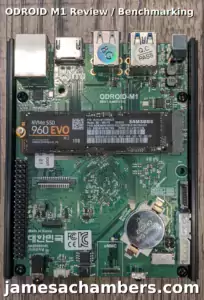


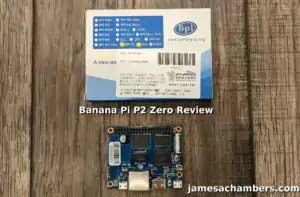
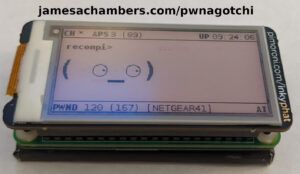
Hi James, very comprehensive & excellent review of the Orange Pi 5. I have an Acer Aspire C22 820 AIO which is constantly having video problems. It is running on Ubuntu 22.04.02. I am seriously considering changing the motherboard, which is basically a SBC into Orange Pi 5. I checked the space & it will fit with no problems. I am expecting with this mod, I will be getting much much better video. The Acer monitor is very good, the video output of the original Acer SBC is problematic though. It is an intel CPU with integrated graphics hardwired to the board. I suspect the LVDS cable too, & this will be the confirmed when the new LVDS cable I ordered arrives. A second option is to mate an Asus Gaming monitor with the Orange Pi 5 & build a DIY AIO computer. What do you think? Thanks for all the reviews, I learned a lot from your reviews. . BTW my use is simply home office work, browsing, watching movies & editing pictures once in a while, no heavy stuff. .
Hey Joel,
Welcome! So this is a great idea but I wanted to make you aware of some things first. The first thing is that none of the images have 3D driver support except for Armbian. Therefore if you want to try this you have to use Armbian. The 3D support is not included in the image. To install it you have to follow the instructions here:
sudo add-apt-repository ppa:liujianfeng1994/panfork-mesasudo add-apt-repository ppa:liujianfeng1994/rockchip-multimedia
sudo apt update
sudo apt dist-upgrade
sudo apt install mali-g610-firmware rockchip-multimedia-config
Now once you get it all working it’s pretty nice. I wanted to make you aware though that very few images even have 3D driver support included. You’ll pretty much have to use Armbian or a custom image.
If you try to run Ubuntu 22.04 on this board with the official image you will have exactly the same problems. There won’t be real 3D support or drivers in it. Linux 3D support is a bit of a nightmare even under the best of times.
Now theoretically I think if you are running Armbian with the 3D support installed you’ll have a *much* better experience than what you are describing with the Acer. If you try to run anything other than Armbian though it will probably be the same or worse as 3D driver support is not enabled in Ubuntu or any of the official images.
I know this might not be exactly what you wanted to hear but I wanted to be totally honest with you. 3D support is a tough thing for most SBCs. The Orange Pi 5 you do have options but your options will be limited. There are some unofficial images out there as well that are basically the Orange Pi 5 images with 3D support patched in. I wouldn’t feel comfortable telling you it’s going to be a night and day better experience though. It will be a better experience if you use Armbian with the 3D support enabled at least.
Hopefully that helps!
A quick check of Aliexpress show 2 camera boards on sale with different lenses and available through the 3 shops and what’s interesting is its suitable for OPi 5/5B/5 Plus so wonder when we’ll see the announceent of the 5 Plus as that ust be the RK3588 SBC…?
They’ve priced it well and just in time as Raspberry Pi recently released some updates to their own camera range and at under $30AUD / $15USD with discount its not that bad and 500 available so might be worth a review…?
Image #1
Image #2
Hey Razor Burn,
Pricing looks very good! Seeed Studios also recently mentioned me that the ESP32-S3 was released. It looks like it’s only $7.99 so it’s cheaper than the QT Py ones.
I’m definitely interested in covering the camera and will try to get a hold of one!
Thanks for the heads up as I checked the Seeed website the other day and no mention of the XIAO ESP32-S3 Sense with talk of an April release dat so naturally jumped on to order a few boards + headers with hopes of delivery early April.
I’m keen to see how it compares to the ESP32-CAM as its using the newer chip but also realistic that due to size alone its not going to be HD resolution but it looks to be an improvement over the Adafruit QT Py version and a great addition to the Home Assistant project I have in mind.
I’m encouraged to see Orange Pi committed to the PI 5 as they tend to drop a device with little fan fare and in the last few months we’ve seen them release a very capable SBC that’s getting great support from the community, a working Wireless card to pair with their choice of M.2 M keyed slot, a suitable 14″ portable monitor and now supported camera that’s priced well and stocks seem to be available after the recent halt due to holidays so great time if you’re a consumer especially if they get the RK3588 SBC manufactured as there’s clearly a market for an affordable alternative to the Rock 5B!
Take care good sir…
Hey Razor Burn,
I am extremely curious about the camera as well! Here’s what we know so far:
Based, as the name implies, on the Espressif ESP32-S3 system-on-chip (SOC), the XIAO ESP32S3 includes two 32-bit Tensilica Xtensa LX7 cores running at up to 240MHz, 384kB of static RAM (SRAM), and 512kB of on-chip flash plus a real-time clock block with a RISC-V-based ultra-low-power coprocessor. A radio block offers 2.4GHz single-band 802.11b/g/n Wi-Fi connectivity along with Bluetooth 5.0 Low Energy (BLE) connectivity.To this Seeed has added 8MB of pseudo-static RAM (PSRAM) and 8MB of off-chip flash storage, while still cramming the resulting board into its compact XIAO form factor. Unlike previous entries in the range, though, it's not a single-board solution but one split into two.
A factory-fitted expansion board includes an Omnivision OV2640 camera module, offering a 1632×1232 (UXGA) image sensor running at up to 15 frames per second — or 60 frames per second, if you drop down to CIF resolution. The design of the board makes the camera removable, Seeed notes, meaning dropping in a more powerful sensor like the OV5640 will be possible post-purchase.
I think there’s definitely reason to be excited here. It’s the same sensor as the ESP32-CAM but it’s going to have a much more powerful module supporting it. The big thing we’ll want to see is the price to see if it’s a better choice than the ESP32-CAM.
I totally understand what you mean about Orange Pi and I honestly agree. I did my Orange Pi i96 support project and I was really sad to see that the board was basically forgotten and was discontinued shortly after. This is totally how it was a few years ago with Orange Pi (or even a couple of years ago). Their more recent releases seem to have “legs”. The Orange Pi 5 seems like it’s going to stay around for a while and be well supported (through several different variants).
Thanks, you take care as well!
I’m a little bit confused as it appears that they’re releasing 2 versions of the XIAO ESP32-S3 as the one currently for sale is just the base board and the ESP32-S3 Sense with Embedded Camera is supposed to be available on the website next week with late March release date?
The catalog and web presentation only shows the S3 Sense listed for $13.99 which is still a good price and luckily the other version is preorder so I managed to cancel before it shipped but not sure if anybody else made the same mistake or was it only me…? Don’t get me wrong as the XIAO ESP32-S3 looks to be a slight improvement over the Adafruit QT PY ESP32-S3 as it offers an external antenna like the C3 version and $7.99 USD is a very good price.
Hey Razor Burn,
For sure, I was surprised they priced it at $7.99. They’ve got a lot more aggressive with their pricing. That would be great if it comes in at $13.99. That would be extremely competitive with the ESP32-CAM.
I actually told my Seeed contact they really need to offer a pre-soldered version of the S3. I’m guessing that the S3 sense will come with it pre-attached like I was alluding to earlier. I’d say that’s the biggest disadvantage vs. the QT Py. The QT Py has the Stemma QT connector which lets you get away with a lot less soldering.
Good catch about the external connector on the ESP32-S3. The funny thing is Adafruit does make a S2 version with an external connector antenna. I haven’t seen a S3 version with one yet though!
Yeah I’ve seen the ESP32-S2 version from Adafruit and Beetle also have an ESP-C3 with expansion board that allows for a screen but as you say the inclusion of STEMMA QT connector is a great advantage and I’m hoping we see more manufactures offer pre-soldered headers as its easy to bridge a pin or damage a component if you aren’t careful or use a wonky soldering tip LOL…
Absolutely! The numbers are so awful on any of my content that requires soldering. It’s way more of a barrier than even I would have guessed.
For example my Adafruit WiFi action key has an average page time of 36 seconds. That basically means people go there and “nope” right out. My WiFi action button? 1 minute and 30 seconds.
Guess what the average page view time is for this Orange Pi 5 review? 42 minutes. That’s the AVERAGE! It also is why it ranks so high on Google. It also means people are reading the comments (and not just the first couple of them). It doesn’t take 42 minutes to read the review. Some of them are probably following along and working on the Orange Pi 5 along the way (and same with the SSD boot guide).
Then if I look at something else I’ve done (that is almost an identical article) like my Minoston smart plug guide? Average length of 10 minutes. That’s a *lot* better and that one is getting a lot more traffic already than any soldering ones and starting to rank. The soldering ones absolutely flop even though I thought some of those were *really* cool.
Soldering content just doesn’t work (at least for me). It’s some of the worst numbers for anything I’ve done. I think it just is too scary to too many people. That stuff will never rank with page view times like that and they’re leaving so fast that I feel like it’s the *second* they see there is soldering the back button is hit.
Of course if I have something cool I want to build that requires it I will still write about it but boy do I get punished in my analytics and page rankings for it. People do not like it on the whole according to the numbers. Hopefully Google is smart enough to start showing that to people it thinks are cool with soldering because the people it’s sending to the article now hate it. It always takes a long time for Google to properly rank content though and find the right keywords.
Take care!
That’s a real shame James as your Home Assistant guides have been maybe the most popular posts for me as they’re really detailed and I wish the manufacturers such as Adafruit or Seeed sold devices pre-soldered as it surely wouldn’t add to costs as much of the work is automated and I’d be willing to pay extra to have a gadget arrive ready to be used instead of fiddling with my soldering iron hoping I don’t stuff things up but I know from personal feedback from a local vendor who makes devices that they mentioned it was unreasonable to them and that learning to solder was a valuable skill so its a hard decision whether to produce content or focus on actual hardware that’s sure to get attention, eg SBCs???
As frustrating as it may seem I really believe you’re on the right patch as this blog has an important place in the community with its great library of valuable information and reference guide for many SBCs and cool gadgets so keep producing the content and the viewership is sure to come as I see more and more users looking for alternatives now that Raspberry Pi have decided to take a break and catch up on supplies so thanks for what you do and especially replying to each comment as that shows you care about your readership and not just about making content for the sake of traffic… Stay well and keep up the outstanding work!
Hey Razor Burn,
Thanks so much, I promise to keep the good content coming!
Hi James,
Looks like we finally have a supported camera for the OPi 5 that seems to be only available via Aliexpress as nothing posted on Orangepi’s own website?
Orange Pi 13MP Camera 13855 Focal Length 300mm,13 Megapixels Suitable for RK3358/3358S OPi 5/5B/5 Plus Boards
Image #1
Image #2
AliExpress Listing
Also I see mentioned in Discord from somebody in the know of a possible “OPi 5 Pro” that plans on using the RK3588 SOC with confirmed specs so maybe we’ll see them challenging Radxa for title of King of RK3588 device…?
Hey Razor Burn,
Oh wow, that is quite the improvement! I got one of the older 1080P cameras but it honestly wasn’t that interesting so I didn’t end up writing much about it. This one is much more interesting.
That would be very interesting if they do a Orange Pi 5 Pro. I was half expecting the Orange Pi 5B to be that but that ended up being a model that just has the WiFi integrated and no M.2 slot. There’s definitely still room for an Orange Pi 5 Pro with a RK3588!
Hi Jaes,
So it looks like the OrangePi 5B SBC is a real thing judging by the reports on Discord and the specs look like they opted for the first version of the board so onboard wireless and eMMC and cheaper price…?
Not sure what to make of it as they’ve removed SPI flash memory, the M.2 slot so does this mean they fixed the bootloader to boot directly from eMMC and what kind of write speeds can we expect as SD Card is slow and no mention of the PCIE 2.0?
It also looks like the images are of the V1.0 board which shows no certification markings which is a red flag for me so I’ll happily wait to see what Radxa/OKdo do with the Rock 5A as it looks to be the better option unless this ones priced cheaply enough…?
Thanks from sunny Australia
Hey Razor Burn,
Thanks so much for the heads up, I had not seen this yet! That is very interesting. It’s too bad they had to drop the M.2 slot. I have no doubt this is related to the available I/O on the RK3588S.
It looks to me like they took the Orange Pi 5 and built the WiFi in (as well as a eMMC). This didn’t solve their original problem though. There still isn’t enough available I/O on the RK3588S to keep the M.2 slot so they had to drop it. The only way they could have avoided that is if they upgraded to the full RK3588 which would make it a lot more expensive than I’d imagine this board would be.
That’s definitely the big question is how much it will cost. I don’t see it available to buy anywhere yet. I feel like it can’t cost too much less than the Orange Pi 5 does already but I’ll keep an eye out for any pricing updates.
You also got an interesting reply on the Orange Pi 5 SSD / Boot guide here. I added a translation at the bottom but I believe it was for some of your specific instructions! I have a $300 Adafruit order coming soon with a ton of stuff I’ll be covering as well soon here.
Thanks again and take care!
Hi James,
Thanks for the reply and tip as I try my best to keep up with the comments and missed the friendly reply so I am happy to see a fellow user solve an issue and here’s hoping they enjoy the OPi 5 as its a fun SBC when you get it working properly. I’m not sure if you saw but apparently a user has come up with an optimised version of Ubuntu that comes with 3D acceleration that’s comparable to that experienced using Armbian so awesome to see so much software support!
I see OrangePi have been busy making updates to the Pi 5 as per Github and stock has started to pop back up on Aliexpress after the New Year break so we should expect to see the Pi 5B available soon as they’ve had the test board ready for nearly a year now and the software issues are largely resolved so time will tell…?
Wowzers $300 is a big order so I’m excited to see what you have lined up and if its anything like the previous Adafruit gadgets its going to be epic!? You also reminded me that Seeed are dropping some new products next week and speculation is we’ll maybe see an updated Wio Terminal and some cool Grove sensors/cameras…?
Hey Razor Burn,
No worries at all, you do a great job keeping up with them! I just figured I’d give you a heads up since it pops right up on mine as a new comment. It was actually in the spam filter but when I put it through the translator it was obvious it was legit so I unspammed it and figured I’d give you the heads up.
That’s fantastic that we’re starting to see some additional distros pop up that let you enable 3D support (similar to Armbian). It’s even better that it comes enabled out of the box in the one you referenced. Thanks for sharing that!
The traffic is pretty high on the Orange Pi 5 articles. The SSD boot guide is actually my #1 and the review is still #9. This is nice to see because with a lot of boards there’s a lot of traffic right around launch and then everyone forgets about them. The Orange Pi 5 has only been picking up steam. I feel like the board is doing really well overall and that more people are trying alternatives than ever.
I definitely have a lot of Stemma QT stuff in the order. I have both thermal camera modules, a few different RGB matrix options (including some from Grove and Seeed but also some nice ones from Adafruit), a bunch of Adafruit’s different types of Stemma QT sensors and more. They threw in some stuff like a RP2040 KeeBoar that is interesting. They threw in a bunch of goodies for it being a larger order. They also gave me one of these BBC micro:bit v2 but it’s not clear to me what exactly it’s for to be honest. It was just another one of the freebies along with one of their perma breadboards which are pretty nice too.
It’s not expected for delivery until Monday though but I can’t wait! The Adafruit ESP32-S3 Reverse Feather has been amazing too. I connect a little battery to the built in connector and it basically functions as a UPS. If you have USB connected it will charge it and if the power is disconnected it immediately switches over to battery. There’s no buttons or switches to make it switch which I really like. Definitely stay tuned!
That sounds fun and I’m sure to grab the Reverse Feather once they become available again and maybe even a RP2040 KeeBoar as I recall Adafruit mentioning they might stop making them…? I own a BBC Microbit V 2.1 and you can plug in an adapter to allow you to connect a battery or sensors much like the Grove gear but much more low powered.
Core Electronics in Australia have a whole bunch of devices that work with Microbit and its the main reason how I became aware of microcontrollers and sensors, leading me towards alternatives to the Pico and ultimately ESP32, Seeed and Adafruit. Its really targeted at students who want to learn micropython so a stocking stuffer but still fun testing rando sensors out.
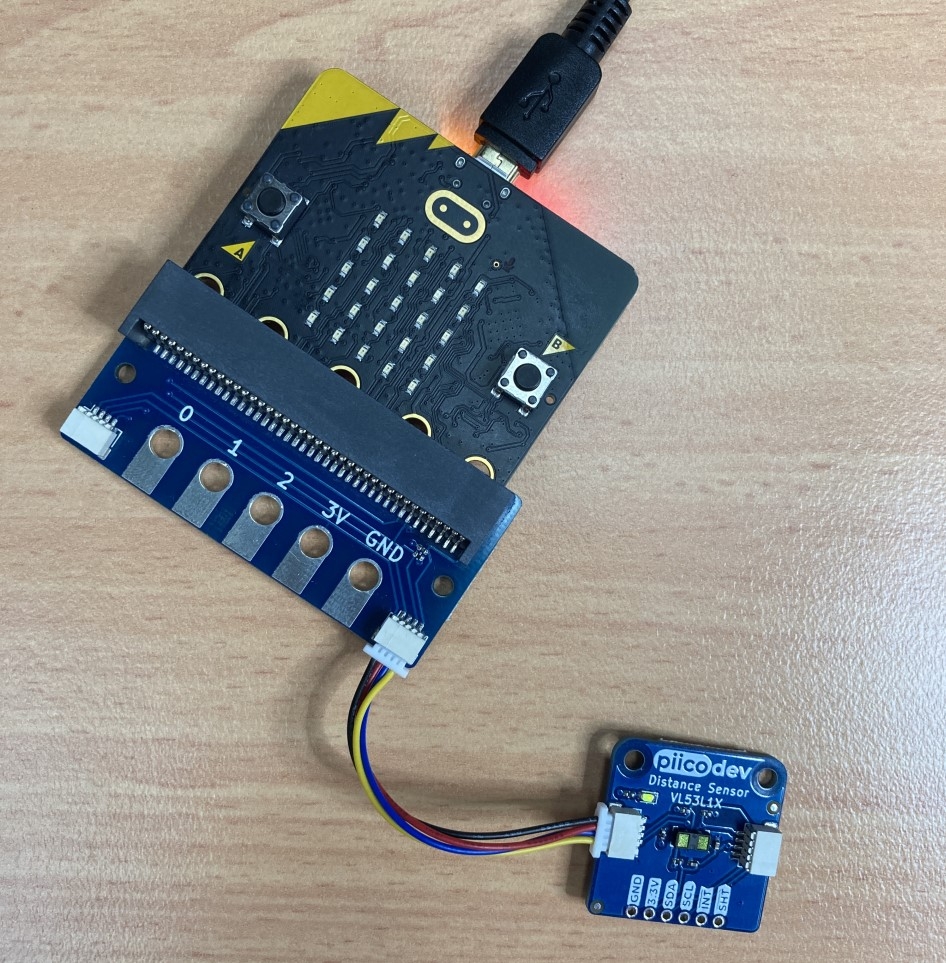
Hey Razor Burn,
Absolutely, the normal TFT feather is probably worth grabbing as well. Whichever one is in stock most likely. The reverse TFT feather though does have 3 buttons the normal one doesn’t which is interesting. The normal one I don’t think they could fit the 3 buttons next to the TFT.
So I didn’t hear that about the RP2040 KeeBoar but I did hear them mention that they probably are going to stop carrying the microbit one. I’d imagine that all of the products they’re giving away for free if you order $200 or $300 worth of stuff is things they are trying to get rid of that they either have too much stock or they are thinking about discontinuing. It might also mean they have way too many (like they might know they have 20,000 sitting in their warehouse or something like that) but in their last big mega Adafruit video I do remember them mentioning the micro.bit one was probably the last chance to get it from them.
I do have a Circuit Playground Express and have done a little bit with MicroPython. It actually does look pretty nice. Some of the things that take me 20-30 lines in Arduino would end up being 2-3 lines in Circuit Python. I definitely understand why Adafruit prefers it especially for people that are beginners / learning. I’m pretty comfortable with Arduino because it works pretty much the same way it did 10 years ago. It looks familiar to me but I’m willing to try Circuit Python as well and will do some coverage of it at some point. I do have some of the gear meant for it at least.
Seeed has some interesting mmWave sensors coming out that look interesting to try. I get the feeling that Adafruit is on Seeed’s radar now. Some of their recent announcements and price cuts I almost feel like are due to Adafruit (or companies like Adafruit). The last time I spoke to Seeed I asked them if there was anything they wanted to send me to cover and all they asked me for was commercial leads. They weren’t interested in consumers at all at the time. I think that’s a mistake just like I think it’s a mistake when Raspberry Pi turned their back on consumers / makers and went purely to selling to IoT manufacturers directly for years. Now they’re practically irrelevant and once you’ve gone down that road even when you “wake up” it takes a minimum of 6-12 months to pivot and produce different/new hardware.
In other words I feel like Seeed doesn’t want us very much and is much more focused on enterprise/business. A year ago it was different. I’d imagine this is because what is happening with the silicon industry in China (nothing good). Over 4000 ICs have closed in China in the past few months so anyone making hardware is freaking out right now and wants BIG business leads. Again, I think it’s a mistake, but I understand why that is their focus. Adafruit on the other hand I know is making stuff for us. When you watch their YouTube videos it’s so clear that we’re the target and I do like being catered to with these products.
Take care!
Does the 2242 SSD slot on Orange Pi 5 support dual side ssd thickness like SABRENT 512GB Rocket NVMe PCIe M.2 2242 ?
Hey Jan,
Great question. So fortunately the answer should be yes. The first thing I tried to answer this was I flipped my current SSD over to see if it would still be able to reach the slot (even though it wouldn’t plug in due to the keying being reversed from flipping it). It was.
I then thought of a better way of figuring this out though which is are people doing it on pibenchmarks.com. I was delighted to see that there were a bunch of Sabrent Rocket tests.
Are they 2242 though? It’s possible people might not have been mounting them and putting the full size 2280 Sabrent Rocket and just having it hang off the edge of the board.
To find out I clicked the first one I saw which was this one. If you look at the “Model” under “Storage Details” it is:
SB-1342-2TBYep, that 42 in the last 2 characters in the middle of the string between the dashes does mean it’s a 2242. So not only should this drive work but it looks like people are already using it successfully with the Orange Pi 5. It holds #5, #6 and #8 on the top 10 Orange Pi 5 scores right now for that drive.
Hopefully that helps!
I bought this board to create a hugue tablet for the kitchen, as a gift to my wife. I bought a TP-Link Archer T2U WiFi but isn’t recognized by Android; so I installed Ubuntu Jammy and worked like a charm. But Netflix doens’t work because wivedine isn’t availiable in ARM64. There’s a way to install chromium on ubuntu with wivedine support? Or I just wait to get released an newer android version? (I tried to SSH over LAN without luck)
Hey Roberto,
So as far as I know this still can’t really be done. The issue is that Wivedine isn’t available for ARM64. The Raspberry Pi can only use Wivedine if you use 32 bit ARM so it’s the same issue with the Raspberry Pi actually if you are using a 64 bit OS. This still seems to be true today that there’s no ARM64 package for Wivedine available.
Your Android plan might be the best plan still for this. This still seems to be a problem on ARM64 to this day even for the Raspberry Pi (on ARM64 at least). Hopefully that helps!
Hi *again*, I’m so sorry for bomboarding you with questions, but you probably know the most in this area. I currently have the latest GitHub build of Armbian, and I just installed the GPU acceleration (from the commands on the official Armbian website). Do you also have a problem with the mouse flickering?
Also, oddly enough, KDE Plasma panels freeze sometimes and I have to restart the system to get them to un-freeze.
Did you enable 3D acceleration as per the Armbian instructions:
sudo add-apt-repository ppa:liujianfeng1994/panfork-mesasudo add-apt-repository ppa:liujianfeng1994/rockchip-multimedia
sudo apt update
sudo apt dist-upgrade
sudo apt install mali-g610-firmware rockchip-multimedia-config
If you have done that already then you’d want to post about this at the Armbian forums (or via a GitHub issue). I’ll explain why here. The Orange Pi 5 is a platinum supported board for Armbian so I already see a few 3D graphics troubleshooting threads there.
It’s a tricky question because if you look at those 3D driver support instructions you’ll see that it’s using a PPA. That means that your 3D driver packages aren’t even really coming from the normal apt sources. Whether you use a public download or a bleeding edge GitHub release or a weekly you will get those same packages that are in the PPA. Even if your version is much newer (or much older) you’ll still get the same files everyone else does from the PPA. Even worse some of these are dependencies you will already have on the system which will get overridden by the version from the PPA (whether it’s really 100% compatible or not, or has even been tested).
Are they compatible with the exact version you are using? Are they compatible with KDE Plasma? I have no idea. I kind of doubt it to be honest. There’s no Armbian distro where KDE Plasma is the default right? Which exact version are you using?
I wouldn’t expect anything but using the default desktop choices to work with these without additional configuration. I’m sure they can be made to work but look at the PPA right here:
chromium-browser 1:110.0.5481.4-0ubuntu1~jammy~rkmpp20230130 JianFeng Liu (2023-01-30)clapper 0.5.2-5+jammy1 JianFeng Liu (2023-01-31)
ffmpeg 7:4.4.2-0ubuntu0.22.04.1+rkmpp20230207 JianFeng Liu (2023-02-07)
gst-plugins-base1.0 1.20.1-1+rk230129+1 JianFeng Liu (2023-01-29)
gstreamer1.0-rockchip 1.14-4+git230111.546cb91 JianFeng Liu (2023-01-29)
kodi 2:19.4+dfsg1-2+gles2 JianFeng Liu (2023-02-03)
librga 2.2.0-1+git220920.c1d5c71~jammy JianFeng Liu (2022-11-16)
librist 0.2.7+dfsg-1+jammy JianFeng Liu (2023-01-31)
libv4l-rkmpp 1.5.1-1.1+git230130.b004755~jammy1 JianFeng Liu (2023-02-06)
moonlight-embedded 2.5.3.1-1+git221204.00c28f5 JianFeng Liu (2023-01-30)
moonlight-qt 4.3.1-1+git230203.90e25e6+1 JianFeng Liu (2023-02-16)
mpp 1.5.0-1+git230210.c145c84~jammy1 JianFeng Liu (2023-02-13)
obs-gstreamer 0.3.5-1 JianFeng Liu (2022-12-15)
obs-studio 28.0.1+dfsg1-3+jammy1 JianFeng Liu (2023-02-02)
rockchip-multimedia-config 1.0.0-2+jammy JianFeng Liu (2023-02-11)
This is messing with a lot of packages. That’s only one PPA. Here’s another one:
gl4es 1.1.4-1+git230110.9df8c98~j JianFeng Liu (2023-02-14)libmali-dri2to3 1.0.2.4 JianFeng Liu (2023-02-18)
mali-g610-firmware 1.0.0-1 JianFeng Liu (2023-02-13)
mesa 23.0~panfork~csf~git221210.120202c6757~k JianFeng Liu (2022-12-12)
mesa 23.0~panfork~csf~git221210.120202c6757~j JianFeng Liu (2022-12-12)
Yikes. Those are all very important system packages many of which are going to be used (or are dependencies of) KDE Plasma. If they aren’t all configured exactly right for your environment by the PPA owner then I’m sure something is going wrong. Notice that you even need a custom Chrome package for 3D support to work properly.
You’d probably need to dive through the log files to set up a non-standard configuration like this that isn’t in the default offerings I’d think. The further you stray from the beaten path of basically Jammy Gnome and some of the official offerings here it’s doubtful that those packages are configured to set up a proper 3D environment.
Some places to check are sudo dmesg and your xorg logs and places like that. You’d be looking for errors in those places indicating what is wrong. You can see though that the PPA is serving the version that the PPA happens to be serving at the time. The only two repo choices are Jammy and Kinetic so everyone is getting the same version. You can see how complicated it gets though with that many system packages involved here.
It’s going to all completely depend on exactly which image you are running (and from where) and which flavor (and which desktop) for sure. I’d imagine that if you start looking through the logs you will find that either in dmesg or xorg (or perhaps the desktop manager log) that 3D acceleration isn’t actually working for some reason in there (which the messages will at least give a place to start on what to do to fix it).
This is most likely why they didn’t enable the PPA by default in the image. It would be a valid question if someone asked “why isn’t this just enabled by default in the image”? Probably because it only works with certain configurations. It will very likely break a lot of other configurations that it has never been tested with (and problems have never been reported for them). If they don’t enable it by default then it just falls back to non-accelerated graphics (but it will still work). Enabling this by default in the image would probably cause these types of issues for a lot of other desktops than just KDE Plasma I’d imagine.
One thing I would recommend doing is try doing this exact same thing with the default Gnome distribution or one of the default desktops. It would be worth not only comparing if it flickers and all of that but take a look at dmesg and the log files and see how they compare when running KDE Plasma. I’d be surprised if you experience this on a standard configuration. I’m guessing it’s simply that it’s not set up to configure KDE Plasma to do this at least via the PPA. You might have to do some legwork on your own to finish up configuration completely for it but the log files will help.
We can really hope that since this board is officially supported by Armbian that perhaps the 3D support won’t have to come from some third party PPA before too long. It’s also not enabled by default. My understanding is if you don’t install that PPA as per the Armbian install instructions the 3D support won’t work at all (just like the official images). I mean it will work but it won’t have any acceleration (which is why you’ll notice annoying things like you’re seeing here). As to whether it can configure KDE for you I’m not sure but it doesn’t sound like it. With any luck it might only need one or two config file changes to fix this (or perhaps installing a missing firmware file if dmesg complains about GPU/Mali firmware).
In my opinion for a platinum supported partner board everything to do with 3D should just work out of the box (no matter what desktop you’re using). Unfortunately I don’t think we’re there yet. Armbian is the only one I know if that it’s really possible to even get the 3D support going at all with. As janky as this is having some kind of PPA you have to install it’s still better than what the official images offer (nothing). I’d say the best bet to have this work by just installing the PPA (and nothing more) is to stay pretty close to the official standard OS desktop offerings.
I couldn’t recommend reporting this issue more though either via the Armbian forums or GitHub directly. They might not even really know about this. I didn’t see people calling out KDE Plasma specifically on the Armbian Orange Pi 5 forums. In fact I don’t see anyone talking about it at all really so you might be the first person who has found these issues. I really think they’d fix / investigate these for you since it sounds like Orange Pi handed them a giant bag of money since they’re listed as some kind of platinum support official partner now. You could potentially pursue this via Armbian or via the PPA owner/maintainer depending on what the actual issue ends up being (although I think encouraging Armbian to handle the 3D driver support themselves without using this PPA wouldn’t hurt either).
Hopefully that helps!
Hi, I’ve tried it on XFCE, and the mouse flickering thing still occurs. When I run
sudo apt install mali-g610-firmware rockchip-multimedia-configit reports that they’re both at the newest version, so I think that’s in a working condition. I’ll post this on the forums though!Hey ByteAtATime,
Fantastic testing, I was really hoping you’d say that actually. I actually found something related to the mouse cursor flickering with your updated information. There’s actually a ton of different things to try in there. There’s some xorg.conf changes, setting the cursor to be a software cursor and a bunch of other really promising tweaks in there.
It definitely could be a screen / HDMI compatibility issue. Do you have any other screens to test with to see if it happens on multiple monitors? The only reason I mention it is that if you get to page 2 it sounds like HDMI issues did end up explaining some of these. Yours sounds a little bit more specific to me though and I’d expect something more like an xorg.conf change to fix this (or potentially setting the mouse to use software mode in the driver as per some of those suggestions).
There’s also a pull request related to the flickering cursor here. This was actually merged it looks like in January but whether it’s in our versions or not I couldn’t say.
The good news is it looks like this is a known issue and there’s a bunch of stuff out there to try. Hopefully that helps, let me know what you find!